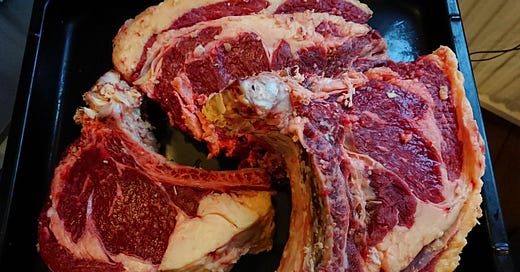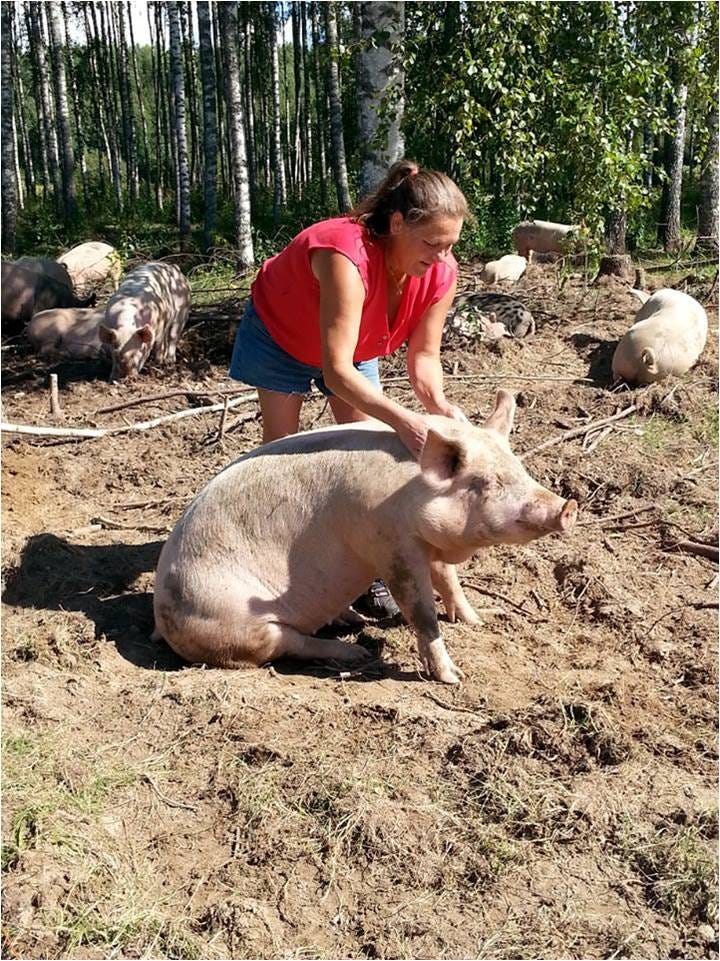Statements about the impact on health and the environment of red meat abound. But what is red meat and what is the common denominator of those meats?
A lot is said about the health and environmental impact of red meat. Mostly negative.
I do engage quite heavily in the debate about the environmental impact of diets in general and in particular about the impact of consumption of meat and milk from cattle. In general, I believe that from an agricultural point of view, kept in the right way, ruminants are really environmentally benign and make a positive contribution to the agriculture and food system. Other animals can also play a beneficial role. Household pigs fed on scraps and by-products can be net contributors to the food system with no negative environmental impact. In the end of this article you find links to a number of articles I have written about livestock in the agri-food system.
In contrast, I hardly ever write about the health impact of certain foods for a number of reasons. One is that I find it almost impossible to draw conclusions about the impact of single foods as opposed to diet patterns. Another is that in my view that diets, in a big picture perspective, have almost always been determined by production and not by dietary choices of individuals. Already the fact that almost everything we eat today is derived from crops and animals that were domesticated thousand years ago or more is a strong indicator how much of the diets that are determined by choices made by our ancestors. That diets in East and South Asia are rich in rice and diets in Europe are rich in wheat is not because Europeans have chosen bread in the shop, and that Asians chose rice, but because European farmers grew wheat and Asian farmers grew rice. It also seems to me that humans have been able to survive and event thrive on very different diets over millennia. Perhaps some was better than the other.
Because of the reasons above, I find it quite futile to engage in the healthy food debate apart from very broad strokes such as “avoid ultra-processed food”, “eat a varied diet”. My experience from reading thousands of scientific food & environment articles is that you really have to read them with a very critical eye and check the methods and certainly not only read the abstract. And I simply don’t want to spend the same time also on food & health articles.
Anyway, in this article I want to explore more what red meat is and if there is any basis for making general statements about the impact of red meat, in particular about health.
According to the IARC, red meat is meat from beef, pork, lamb, and goat from domesticated animals and doesn’t include poultry and game. The NHS has a similar definition. On contrary, the Swedish Food Agency says : By red meat, we mean beef, pork, lamb, reindeer and game. So some think that game is read meat and some don’t.
What is the mechanistic plausible cause of the health effects of red meat consumption?
If any common feature is mentioned, it is heme iron. According to one study in the US, a chicken thigh has more heme iron than a pork chop. And according to another study, shrimp and green mussels have a lot more heme iron than beef and fish more than pork. Even funnier is that a number of plant based meat analogues, such as Impossible, do add heme iron to their products. If heme iron is the health culprit, then we should avoid fish, shrimp, chicken and those meat analogues as well. Even just looking at the color makes the classification of red meat dubious. A village chicken in Uganda certainly has a lot darker red color than an industrial pig in Sweden. And the meat of deer is a lot darker read than any pig’s meat. The steps from these contradictory definitions and to a credible explanation of how and why red meat should have any particular damaging consequences (the mechanistic plausible cause) is murky to say the least. It seems difficult to ascribe results from beef to pork or lamb if you are not sure of what is causing the alleged negative effects.
I also find it strange that almost no research differentiates between cooking methods. Most research seems to take place in high income countries where frying and grilling are very common. But traditionally, and still in many places, most meat is boiled (when I was a child, the only fried meat we ate were pork chops, some sausages and meat balls, most meat was either boiled or slowly baked in the oven). Research mostly identify “processed” red meat, i.e. sausages etc., as a risk factor. But processing is a kind of cooking method. If such a method makes a difference, one can expect that also other cooking methods make a difference. For example, it is quite well established that grilling increases the levels of carcinogenic substances.
And then there is the question of how you raise animals. There is a huge difference between grass-fed beef and feed lot style beef, or between an industrial pig or a pig out rooting. Research from the US showed that a total of 907 out of 1575 compounds differed in abundance between pasture-finished and grain-finished beef samples (!).
A total of 907 out of 1575 compounds differed in abundance between pasture-finished and grain-finished beef samples.
Recently the Nordic Nutrition Recommendations were revised and they lowered the recommendations for consumption of red meat to that it shouldn’t exceed 350 grams (ready to eat) per week. However, when reading the main reference for the recommendations by Jelena Meinilä and Jyrki K Virtanen. Meat and meat products – a scoping review for Nordic Nutrition Recommendations 2023, a much more nuanced view is expressed. In particular, the researchers express how many uncertainties there are in relation to red meat consumption and echo most of my concerns:
"There are also several other outstanding questions, for which comprehensive research data are lacking. These include (in no particular order) the following: Is red meat from game or grass-fed animals healthier than the red meat from animals raised by conventional intensive agriculture? What is the health impact of organ meat intake? What is the health impact of the different cooking methods of meat? What is the impact of lean versus fatty meat on the risk of diseases? Do the health impacts of red meat from different species (e.g. beef, pork, and sheep) differ from each other? "
With all these outstanding questions, it is hard to understand how food agencies at all can make any general statement about the health impact of the consumption of red meat.
Other articles on the role of livestock in the agri-food system and its environmental impact:
A fixed meat ration is not the path to sustainable food systems






When I became a vegetarian in 1970, it was because of the toxins in industrial meat production, as well as the corporate stranglehold on small farmers. People forget that more farmers left the farm in the 1960s than at any other time - at least in the US. We got out in 1965. So it was more of a political move, rather than for health reasons. The greater health benefits came along later. In 1971, Diet for a Small Planet came out and that was a real eye-opener in combining amino acids in various foods. (Lappe's star pattern is similar to Liebig's barrel, by the way. Same kind of thinking that one deficient nutrient limits the others.) Likewise the emphasis on whole grains, which was nurtured by the food co-ops in the early 1970s. In 1981, after passing up about a thousand free meals, I came off the vegetarian bandwagon and defaulted to a little bit of meat, mostly for flavoring. This is now known as flexitarianism and it is a more balanced approach. Here in France we have access to locally-grown meat, eggs and dairy, so I don't worry about the corporate stranglehold as much. I have a quite different take on cows and pigs and chickens than Gunnar and most small holders who have animals. Cows were the bane of my existence for the first fifteen years of my life and so I don't have any. If you query the smallholders who have animals, you usually find they really, really like animals. Therefore, they don't mind not being able to leave the farm at will and the extra level of infrastructure. I never had a vacation until I was an adult. Consequently, I will pay any price the neighbors want for their eggs and any price for the cheese and meat I buy in the local markets. Since I don't have to do the work, any price is a good deal. Remember, if the local beef is twice as good and only costs 50% more than the crap in the supermarket, the local beef is a big win.
That is some beautiful looking beef!